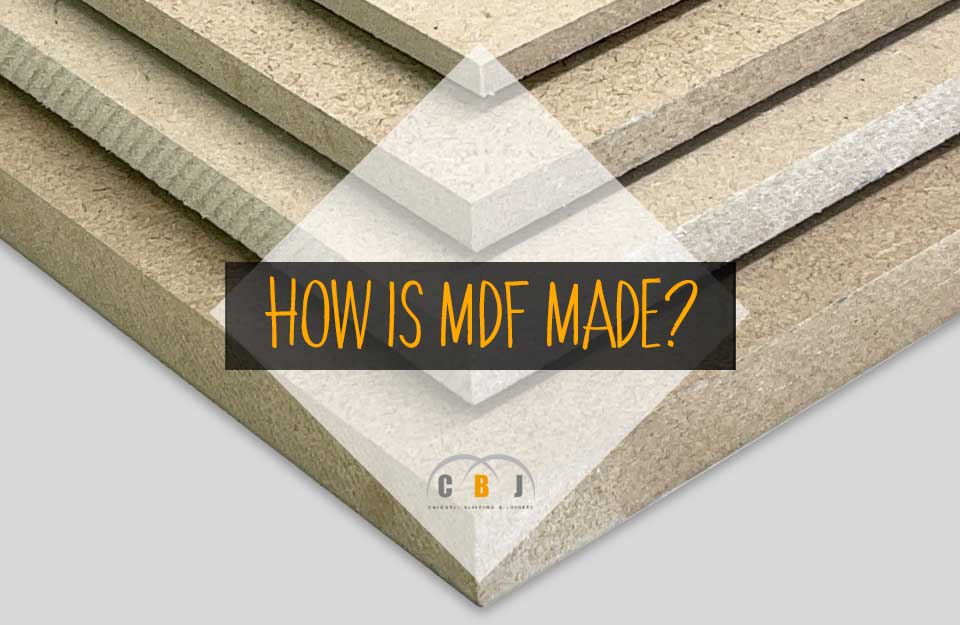News
How is MDF Made?
Author Chigwell Building & Joinery
Date 01/10/2023
MDF is a popular type of engineered wood used in various projects.
While it is often confused with plywood, it’s not the same as it’s denser and stronger.
Table of Contents
- What is MDF?
- Physical Properties of MDF
- Typical Applications
- MDF Fibre Preparation
- MDF Sheet Formation
- Advantages of MDF
- Disadvantages of MDF
- Conclusion
What is MDF?
MDF stands for medium density fibreboard.
This engineered wood product has gained a great deal of popularity over the years as it offers various advantages.
This includes affordability and the fact that it can be used for a myriad of purposes, ranging from home furniture to decorative products.
In fact, it’s often thought to be the same as plywood or fibreboard.
This is not the case however, as it’s considerably denser and a fabricated product using various elements.
MDF is composed of hardwood or softwood residuals which are broken down into wood fibres.
They then combined together with wax and resin binder by applying very high pressure and heat.
Physical Properties of MDF
Image credit: Amazon
MDF is made up of 82% wood fibre and 9% resin.
Urea-formaldehyde resin glue is used.
There is 8% water and 1% paraffin wax added to this, to ultimately achieve the density desired from the boards.
In fact there are different densities and classifications of MDF, namely light, standard, flame retardant, high density and exterior MDF boards.
MDF is considerably uniform when compared to natural woods.
It does not contain any rings or knots on the surface area.
MDF has a flat and smooth surface which makes it ideal for veneering as there are no underlying grains or imperfections.
Typical Applications
MDF is used for a wide variety of applications and projects nowadays.
MDF is best used for indoor applications as it’s widely known to have poor moisture resistance.
It’s commonly used to build home furniture, such as cabinets, drawer fronts and shelves.
It’s also a popular option for wall linings, partitions and school projects as it’s very flexible and versatile.
MDF is commonly used for flooring and wainscoting too.
The density of MDF boards make it an ideal choice for decorative overlays and to make the walls of pipe-organ chambers.
It is also used in speaker boxes and theatre set construction.
MDF Fibre Preparation
Image credit: Pexels
The following processes need to be carried out to produce MDF:
Debarking
Logs used are debarked since the bark is not ideal for use in wood-based panels.
The bark is thus removed from the logs by means of drum or rotor debarkers.
In the former, the logs will rub against the drum and one another, thereby removing the bark.
If a rotor debarker is used, each log rotates around its longitudinal axis, and through the rolling process the rotor will peel off the log’s bark.
Chipping
The round wood is chipped into wood chips.
The size of these chips will determine the length of the flakes or fibres achieved later.
A drum chipper or disc chipper is used for this process.
Washing
The wood chip washing stage refers to when stones, sand, or any other fine non-metallic foreign objects are washed out of the wood chips.
Refining
The wood chips will subsequently undergo refining in a refiner in order to be ground into high quality fibres suitable for MDF sheet formation.
This is important to ensure a uniform quality in the fibres.
The wood chips will first be boiled and then taken to the refiner, where they get defibrated.
Generally single-disc refiners are used for this process.
MDF Sheet Formation
Following the above stages, the MDF sheet formation can then take place.
This comprises various phases, namely:
Glueing
When glueing, it’s critical to apply a precise dose of adhesive.
This is added to the fibres and is important that it gets evenly distributed.
In order to determine the specific amount of adhesive needed, the weight of the wood will be measured using a belt weigher.
Sometimes substances are added to the adhesive to improve its moisture resistance or for fire protection.
Forming
The glued fibres will then be spread out evenly onto a conveyor belt which is continuously running.
Liquid Application
Next, release agents, water and any other additives will be sprayed onto it, prior to proceeding to the pressing stage.
Pressing
During pressing, the glue will be cured as a result of the pressure and high temperature being applied.
The mat composed of fibres and flakes will be pre-pressed and then transferred to the press to be pressed to the required thickness.
The glue will harden, and as a result the wood particles will be plasticised.
Multi-opening presses and continuous presses can be used for this process, with the latter being the most popular as they offer a higher output.
Advantages of MDF
Some of the advantages of MDF include:
- It is flexible
- It can be painted
- It is consistent both in strength and size
- It is strong and not susceptible to splitting when screws are installed or pulled out
- It is less prone to expansion and contraction than natural wood
- It bonds well to wood glue
- It can be laminated and doweled
Disadvantages of MDF
The main disadvantages of MDF include:
- Low moisture resistance, so warping could occur if exposed to high humidity
- May release formaldehyde which is a human carcinogen
- It is denser than chipboard or plywood so not ideal for some applications
- If it is a low grade MDF it can swell and break as soon as it is exposed to water
- It tends to dull cutting blades much more quickly than other types of wood
Conclusion
As you will have discovered, the manufacturing process of how MDF is made contains a number of stages.
From sourcing, debarking and chipping the wood, to refining, glueing and pressing, MDF is a material that takes its form from a combination of intricate manufacturing techniques.
But the end product is a highly versatile and strong material that many trades use for a variety of applications.
The versatility and affordability of MDF makes it one of the most popular materials used in a myriad of projects nowadays.
MDF can be cut to size, laminated and edged to create a variety of stunning bespoke furniture pieces from cabinets, to kitchen units to custom wardrobes and more.
So it’s no wonder MDF is such a popular and commonly used building material.


